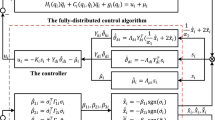Abstract
This paper provides a solution to the leader-follower consensus problem in networks composed of multiple heterogeneous robots, modeled in the operational space. Using a simple distributed proportional controller and without using velocity measurements, the paper shows that all the robots in the network asymptotically reach a given leader pose (position and orientation) provided that, at least, one follower robot has access to the leader pose. The singularity-free unit quaternions are used to describe the orientation of the robots manipulators. The effectiveness of the theoretical results is validated through numerical simulations of a network composed of ten robots with 6-Degrees-of-Freedom (DoF).
Access this chapter
Tax calculation will be finalised at checkout
Purchases are for personal use only
Preview
Unable to display preview. Download preview PDF.
Similar content being viewed by others
References
Liu, Y., Chopra, N.: Controlled synchronization of heterogeneous robotic manipulators in the task space. IEEE Trans. Robot. 28(1), 268–275 (2012)
Aldana, C., Nuño, E., Basañez, L.: Bilateral teleoperation of cooperative manipulators. In: IEEE Int. Conf. Robot. Autom, pp. 4274–4279 (May 2012)
Rodriguez-Angeles, A., Nijmeijer, H.: Mutual synchronization of robots via estimated state feedback: A cooperative approach. IEEE Trans. Control Syst. Technol. 12(4), 542–554 (2004)
Nuño, E., Ortega, R., Basañez, L., Hill, D.: Synchronization of networks of nonidentical Euler-Lagrange systems with uncertain parameters and communication delays. IEEE Trans. Autom. Control 56(4), 935–941 (2011)
Hatanaka, T., Fujita, Y.I.M., Spong, M.: Passivity-based pose synchronization in three dimensions. IEEE Trans. Autom. Control 57(2), 360–375 (2012)
Lee, D., Spong, M.: Stable Flocking of Multiple Inertial Agents on Balanced Graphs. IEEE Trans. Autom. Control 52(8), 1469–1475 (2007)
Gu, D.-B., Wang, Z.: Leader-follower flocking: Algorithms and experiments. IEEE Trans. Control Syst. Technol. 17(5), 1211–1219 (2009)
Wang, X., Yu, C., Lin, Z.: A Dual Quaternion Solution to Attitude and Position Control for Rigid-Body Coordination. IEEE Trans. Robot. 28(5), 1162–1170 (2012)
Qin, J., Zheng, W., Gao, H.: Coordination of Multiple Agents With Double-Integrator Dynamics Under Generalized Interaction Topologies. IEEE Trans. Syst., Man, Cybern. B 42(1), 44–57 (2012)
Zhua, W., Cheng, D.: Leader-following consensus of second-order agents with multiple time-varying delays. Automatica 46(12), 1994–1999 (2010)
Nuño, E., Sarras, I., Panteley, E., Basañez, L.: Consensus in networks of nonidentical Euler-Lagrange systems with variable time-delays. In: 51st IEEE Conf. on Decision and Control, Maui, Hawaii, USA, pp. 4721–4726 (December 2012)
Abdessameud, A., Tayebi, A.: On consensus algorithms design for double integrator dynamics. Automatica 49(1), 253–260 (2013)
Li, Z., Duan, Z., Huang, L.: Leader-follower consensus of multi-agent systems. In: Proc. Amer. Contr. Conf, pp. 3256–3261 (2009)
Ren, W.: Distributed attitude alignment in spacecraft formation flying. Int. J. Adapt. Contr. Signal Process. 21(2-3), 95–113 (2007)
Ren: Distributed cooperative attitude synchronization and tracking for multiple rigid bodies. IEEE Trans. Control Syst. Technol. 18(2), 383–392 (2010)
Abdessameud, A., Tayebi, A., Polushin, I.-G.: Attitude synchronization of multiple rigid bodies with communication delays. IEEE Trans. Autom. Control 57(9), 2405–2411 (2012)
Abdessameud, A., Tayebi, A.: Formation control of VTOL unmanned aerial vehicles with communication delays. Automatica 47(11), 2383–2394 (2011)
Spong, M., Hutchinson, S., Vidyasagar, M.: Robot Modeling and Control. Wiley (2005)
Caccavale, F., Siciliano, B., Villani, L.: The role of Euler parameters in robot control. Asian J. Control 1(1), 25–34 (1999)
Chou, J.: Quaternion kinematic and dynamic differential equations. IEEE Trans. Robot. Autom. 8(1), 53–64 (1992)
Kuipers, J.B.: Quaternions and Rotation Sequences: A Primer with Applications to Orbits, Aerospace and Virtual Reality. Princeton University Press (2002)
Wen, J.-Y., Kreutz-Delgado, K.: The attitude control problem. IEEE Trans. Autom. Control 36(10), 1148–1162 (1991)
Fjellstad, O.: Control of unmanned underwater vehicles in six degrees of freedom: a quaternion feedback approach. Ph.D. dissertation, Norwegian Institute of Technology, University of Trondheim (1994)
Campa, R., Camarillo, K.: Unit quaternions: A mathematical tool for modeling, path planning and control of robot manipulators. In: Robot manipulators, pp. 21–48. InTech (2008)
Hu, J., Hong, Y.: Leader-following coordination of multi-agent systems with coupling time delays. Phys. A Stat. Mech. Appl. 374(2), 853–863 (2007)
Serre, D.: Matrices: Theory and Applications. Springer (2010)
Kelly, R., Santibáñez, V., Loria, A.: Control of robot manipulators in joint space. Advanced textbooks in control and signal processing. Springer (2005)
Corke, P.I.: Robotics, Vision & Control: Fundamental Algorithms in Matlab. Springer (2011)
Spurrier, R.A.: Comment on singularity-free extraction of a quaternion from a direction-cosine matrix. J. Spacecraft and Rockets 15(4), 255 (1978)
Mazo, F.: Modelado dinámico y simulación del robot industrial stäubli TX90. Masters thesis (2011), http://upcommons.upc.edu/e-prints/handle/2117/520
Author information
Authors and Affiliations
Corresponding author
Editor information
Editors and Affiliations
Rights and permissions
Copyright information
© 2014 Springer International Publishing Switzerland
About this paper
Cite this paper
Aldana, C.I., Romero, E., Nuño, E., Basañez, L. (2014). Operational Space Consensus in Networks of Robots: The Leader-Follower Case. In: Armada, M., Sanfeliu, A., Ferre, M. (eds) ROBOT2013: First Iberian Robotics Conference. Advances in Intelligent Systems and Computing, vol 253. Springer, Cham. https://doi.org/10.1007/978-3-319-03653-3_42
Download citation
DOI: https://doi.org/10.1007/978-3-319-03653-3_42
Publisher Name: Springer, Cham
Print ISBN: 978-3-319-03652-6
Online ISBN: 978-3-319-03653-3
eBook Packages: EngineeringEngineering (R0)




